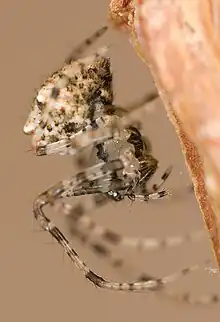Ero
Ero is a genus of pirate spiders first described in 1836.[1] They resemble comb-footed spiders due to their globular abdomen, which is higher than it is long.[2]
| Ero Temporal range: | |
|---|---|
 | |
| Ero aphana, female | |
| Scientific classification | |
| Domain: | Eukaryota |
| Kingdom: | Animalia |
| Phylum: | Arthropoda |
| Subphylum: | Chelicerata |
| Class: | Arachnida |
| Order: | Araneae |
| Infraorder: | Araneomorphae |
| Family: | Mimetidae |
| Genus: | Ero C. L. Koch, 1836 |
| Species | |
|
See text | |
Description

The upper side of their abdomen bears one or two pairs of conical tubercles and some curved bristle-like hairs. The anterior medial eyes project on small tubercles. Leg 1 is nearly twice as long as leg 4.
Their egg sacs are uniquely shaped elongated globes, about four millimetres in diameter. They are suspended from vegetation on a silken thread, and are made from an inner layer of yellowish brown silk and an outer layer of dark coloured, loosely woven silk, giving it a "woolly" appearance. The sacs are not guarded by the female, so when the juveniles hatch, they have to fend for themselves. Since Ero species are nocturnal, the adults are not often seen and the egg sacks often reveal their presence before specimens are found.[2]
Feeding behaviour
Spiders in this genus are specialised spider killers. They attack potential victims by biting one of its legs and injecting toxins. It quickly retreats as the prey spider becomes paralysed. When its prey is immobile, it feeds by sucking out the victim's body fluids.[3]
Species
The World Spider Catalog lists these species:[4]
- Ero aphana (Walckenaer, 1802) — Palearctic (St. Helena, Queensland, Western Australia, introduced)
- Ero cachinnans Brignoli, 1978 — Bhutan
- Ero cambridgei Kulczyński, 1911 — Palearctic
- Ero canala Wang, 1990 — China
- Ero canionis Chamberlin & Ivie, 1935 — USA
- Ero capensis Simon, 1895 — South Africa
- Ero catharinae Keyserling, 1886 — Brazil
- Ero comorensis Emerit, 1996 — Comoro Islands, Seychelles
- Ero eburnea Thaler, 2004 — Ivory Coast
- Ero felix Thaler & van Harten, 2004 — Yemen
- Ero flammeola Simon, 1881 — Portugal to Corfu, Canary Islands
- Ero furcata (Villers, 1789) — Palearctic
- Ero furuncula Simon, 1909 — Vietnam
- Ero galea Wang, 1990 — China
- Ero ganglia Yin & Bao, 2012 — China
- Ero gemelosi Baert & Maelfait, 1984 — Galapagos Islands
- Ero goeldii Keyserling, 1891 — Brazil
- Ero gracilis Keyserling, 1891 — Brazil
- Ero humilithorax Keyserling, 1886 — Brazil
- Ero japonica Bösenberg & Strand, 1906 — Russia, China, Korea, Japan
- Ero jiafui Yin & Bao, 2012 — China
- Ero juhuaensis Xu, Wang & Wang, 1987 — China
- Ero kompirensis Strand, 1918 — Japan
- Ero laeta Barrientos, 2017 — Portugal, Spain
- Ero lata Keyserling, 1891 — Brazil
- Ero lawrencei Unzicker, 1966 — South Africa
- Ero leonina (Hentz, 1850) — USA
- Ero lodingi Archer, 1941 — USA
- Ero lokobeana Emerit, 1996 — Madagascar
- Ero madagascariensis Emerit, 1996 — Madagascar
- Ero melanostoma Mello-Leitão, 1929 — Brazil
- Ero pensacolae Ivie & Barrows, 1935 — USA
- Ero quadrituberculata Kulczynski, 1905 — Madeira
- Ero salittana Barrion & Litsinger, 1995 — Philippines
- Ero spinifrons Mello-Leitão, 1929 — Brazil
- Ero spinipes (Nicolet, 1849) — Chile, Argentina
- Ero tenebrosa Lissner, 2018 — Canary Islands
- Ero tuberculata (De Geer, 1778) — Palearctic
- Ero valida Keyserling, 1891 — Brazil
References
- Koch, C. L. (1836). Herrich-Schäffer, G. A. W. (ed.). "Arachniden". Deutschlands Insecten. Heft: 134–141.
- "Family: Mimetidae (Pirate Spiders)". Spiders of Europe and Greenland. Archived from the original on 2018-10-10. Retrieved 2019-02-27.
- Nieuwenhuys, Ed. "Spider enemies". Retrieved 2019-02-27.
- "Gen. Ero". World Spider Catalog. Natural History Museum Bern. Retrieved 2019-02-27.
External links
![]() Media related to Ero at Wikimedia Commons
Media related to Ero at Wikimedia Commons